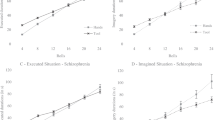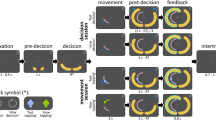Abstract
Two experiments examine whether people overestimate the benefits provided by tool use in motor tasks. Participants had to move different quantities of objects by hand (two at a time) or with a tool (four at a time). The tool was not within reach so participants had to get it before moving the objects. In Experiment 1, the task was performed in a real and an imagined situation. In Experiment 2, participants had to decide for each quantity, whether they preferred moving the objects by hand or with the tool. Our findings indicated that people perceive tool actions as less costly in terms of movement time than they actually are (Experiment 1) and decide to use a tool even when it objectively provides less time-based benefits than using the hands (Experiment 2). Taken together, the data suggest that people overestimate the benefits provided by tool use.




Similar content being viewed by others
Notes
The difference between the Hand condition and the Tool condition in the Real situation is particularly important for Experiment 2, so we report here the differences (in s) between the Hand condition minus the Tool condition in the Real situation. Note that a positive difference reflects a gain in favor of the Hand condition, and a negative difference a gain in favor of the Tool condition: Quantity 4 (M = 10, SD = 1.39, range: 8:17), Quantity 8 (M = 6, SD = 3.52, range: 4:13), Quantity 12 (M = 0, SD = 3.38, range: −8:5), Quantity 16 (M = −6, SD = 4.44, range: −18:−1), Quantity 20 (M = −10, SD = 5.05, range: −19:−5), and Quantity 24 (M = −16; SD = 6.35, range: −29:−11). Importantly, these descriptive results indicate that the gain in favor of the Hand condition was present for all the participants for the quantities 4 and 8.
Imagery-related speed gain was submitted to an ANOVA with Path (A–C–A to get the tub vs. A–C–A to return the tub) and Quantity of rolls (4 vs. 8 vs. 12 vs. 16 vs. 20 vs. 24) as within-subject factors. The analysis revealed no significant main effects and no interaction between the factors (Fs < 1).
Another possibility to collect the choices could have been, for each trial, to present the participants with a quantity of rolls, to ask them to choose the condition in which they would move the rolls and to actually move the rolls. However, as explained in Experiment 1, moving the rolls in the Real situation required a substantial amount of time. So this procedure would have taken too much time, preventing the collection of several trials for each quantity. Moreover, we did not decide to ask the participants to actually move the rolls after the decision task for each quantity and in each condition (Tool and Hand). This procedure could have been interesting to compare the choices made by the participants with the time taken to actually move the rolls. Nevertheless, we thought that the participants might have modified their way to move the rolls to be consistent with the choices made during the decision task. We posited that the time taken by the participants of Experiment 2 to actually move the rolls for each quantity and in each condition (Tool and Hand) should be similar to that of the participants of Experiment 1. This assumption is based on the results of Experiment 1 indicating that the time-based benefit between the two conditions was globally constant among the participants of Experiment 1 (see Footnote 1).
References
Baber, C. (2003). Cognition and tool use: Forms of engagement in human and animal use of tools. London: Talyor & Francis.
Decety, J., Jeannerod, M., & Prablanc, C. (1989). The timing of mentally represented actions. Behavioural Brain Research, 34, 35–42.
Flusberg, S. J., & Boroditsky, L. (2011). Are things that are hard to physically move also hard to imagine moving. Psychonomic Bulletin & Review, 18, 158–164. doi:10.3758/s13423-010-0024-2.
Gibson, K. R. (1991). Tools, language and intelligence: Evolutionary implications. Man, 26, 255–264.
Goldenberg, G., & Iriki, A. (2007). From sticks to coffee-maker: Mastery of tools and technology by human and non-human primates. Cortex, 43, 285–288. doi:10.1016/S0010-9452(08)70454-4.
Johnson-Frey, S. H. (2007). What puts the how in where? Tool use and the divided visual streams hypothesis. Cortex, 43, 368–375. doi:10.1016/S0010-9452(08)70462-3.
Kunz, B. R., Creem-Regehr, S. H., & Thompson, W. B. (2009). Evidence for motor simulation in imagined locomotion. Journal of Experimental Psychology: Human Perception and Performance, 35, 1458–1471. doi:10.1037/a0015786.
Macramalla, S., & Bridgeman, B. (2009). Anticipated effort in imagined self-rotation. Perception, 38, 79–91. doi:10.1068/p5905.
Macuga, K. L., Papailiou, A. P., & Frey, S. H. (2012). Motor imagery of tool use: Relationship to actual use and adherence to Fitts’ law across tasks. Experimental Brain Research, 218, 169–174. doi:10.1007/s00221-012-3004-0.
Osiurak, F., Jarry, C., & Le Gall, D. (2010). Grasping the affordances, understanding the reasoning: Toward a dialectical theory of human tool use. Psychological Review, 117, 517–540. doi:10.1037/a0019004.
Osiurak, F., Jarry, C., & Le Gall, D. (2011). Re-examining the gesture engram hypothesis: New perspectives on apraxia of tool use. Neuropsychologia, 49, 299–312. doi:10.1016/j.neuropsychologia.2010.12.041.
Osiurak, F., Morgado, N., & Palluel-Germain, R. (2012). Tool use and perceived distance: When unreachable becomes spontaneously reachable. Experimental Brain Research, 218, 331–339. doi:10.1007/s00221-012-3036-5.
Penn, D. C., Holyoak, K. J., & Povinelli, D. J. (2008). Darwin’s mistake: Explaining the discontinuity between human and nonhuman minds. Behavioral and Brain Sciences, 31, 109–129. doi:10.1017/S0140525X08003543.
Proffitt, D. R. (2006). Embodied perception and the economy of action. Perspectives in Psychological Science, 1, 110–122. doi:10.1111/j.1745-6916.2006.00008.x.
Rosenbaum, D. A., Brach, M., & Semenov, A. (2011). Behavioral ecology meets motor behaviour: Choosing between walking and reaching paths. Journal of Motor Behavior, 43, 131–136. doi:10.1080/00222895.2010.548423.
Rosenbaum, D. A., & Gaydos, M. J. (2008). A method for obtaining psychophysical estimates of movement costs. Journal of Motor Behavior, 40, 11–17. doi:10.3200/JMBR.40.1.11-17.
van Lawick-Goodall, J. (1970). Tool-using in primates and other vertebrates. In D. Lehrman, R. Hinde, & E. Shaw (Eds.), Advances in the Study of Behavior (pp. 195–249). New York: Academic Press.
Witt, J. K. (2011a). Action’s effect on perception. Current Directions in Psychological Science, 20, 201–206. doi:10.1177/0963721411408770.
Witt, J. K. (2011b). Tool use influences perceived shape and perceived parallelism, which serves as indirect measures of perceived distance. Journal of Experimental Psychology: Human Perception and Performance, 37, 1148–1156. doi:10.1037/a0021933.
Witt, J. K., & Proffitt, D. R. (2008). Action-specific influences on distance perception: A role for motor simulation. Journal of Experimental Psychology: Human Perception and Performance, 34, 1479–1492. doi:10.1037/a0010781.
Witt, J. K., Proffitt, D. R., & Epstein, W. (2005). Tool use affects perceived distance, but only when you intend to use it. Journal of Experimental Psychology: Human Perception and Performance, 31, 880–888. doi:10.1037/0096-1523.31.5.880.
Author information
Authors and Affiliations
Corresponding author
Rights and permissions
About this article
Cite this article
Osiurak, F., Morgado, N., Vallet, G.T. et al. Getting a tool gives wings: overestimation of tool-related benefits in a motor imagery task and a decision task. Psychological Research 78, 1–9 (2014). https://doi.org/10.1007/s00426-013-0485-9
Received:
Accepted:
Published:
Issue Date:
DOI: https://doi.org/10.1007/s00426-013-0485-9




